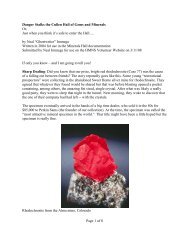Discovery and Analysis of Petrified Wood in the San Jacinto River
Discovery and Analysis of Petrified Wood in the San Jacinto River
Discovery and Analysis of Petrified Wood in the San Jacinto River
You also want an ePaper? Increase the reach of your titles
YUMPU automatically turns print PDFs into web optimized ePapers that Google loves.
<strong>Discovery</strong> <strong>and</strong> <strong>Analysis</strong> <strong>of</strong> <strong>Petrified</strong><br />
<strong>Wood</strong> <strong>in</strong> <strong>the</strong> <strong>San</strong> Jac<strong>in</strong>to <strong>River</strong><br />
Ryan Wallace<br />
Know Junior High School<br />
The <strong>Wood</strong>l<strong>and</strong>s, TX<br />
Conroe Independent School District
<strong>Discovery</strong> <strong>and</strong> <strong>Analysis</strong> <strong>of</strong> <strong>Petrified</strong> <strong>Wood</strong> <strong>in</strong> <strong>the</strong> <strong>San</strong> Jac<strong>in</strong>to <strong>River</strong><br />
Abstract<br />
The purpose <strong>of</strong> <strong>the</strong> project was to analyze petrified wood discovered <strong>in</strong> <strong>the</strong> <strong>San</strong><br />
Jac<strong>in</strong>to <strong>River</strong> for wood type, m<strong>in</strong>eralization type, density, <strong>and</strong> presence <strong>of</strong> iron. It was<br />
hypo<strong>the</strong>sized that most <strong>of</strong> <strong>the</strong> petrified wood would be palmwood, which is <strong>the</strong> state<br />
stone <strong>of</strong> Texas. The petrified wood was polished on one end us<strong>in</strong>g gr<strong>in</strong>ders <strong>in</strong> order to<br />
identify <strong>the</strong> wood type. The petrified wood was weighed <strong>and</strong> <strong>the</strong> volume was determ<strong>in</strong>ed<br />
so as to calculate <strong>the</strong> density. The color was recorded <strong>and</strong> a fluorescent light was shown<br />
on <strong>the</strong> wood to determ<strong>in</strong>e <strong>the</strong> type <strong>of</strong> m<strong>in</strong>erals that caused <strong>the</strong> wood to be fossilized. The<br />
petrified wood was heated so as to show <strong>the</strong> iron. One hundred <strong>and</strong> thirteen pieces <strong>of</strong><br />
petrified wood were collected <strong>and</strong> weighed 12.5 kg. This petrified wood was from <strong>the</strong><br />
Pleistocene to Eocene periods, mak<strong>in</strong>g it 3 to 40 million years old. Hardwood was 76%,<br />
s<strong>of</strong>twood was 11% <strong>and</strong> unknown wood was 13%. There was no palmwood. The average<br />
density was about 2.5 g/ml, but <strong>the</strong>re was no difference between <strong>the</strong> density <strong>of</strong> petrified<br />
wood <strong>and</strong> river rocks. The major colors <strong>of</strong> <strong>the</strong> petrified wood were black, brown, orange,<br />
gray <strong>and</strong> white, mean<strong>in</strong>g that most <strong>of</strong> <strong>the</strong> petrified wood was m<strong>in</strong>eralized with<br />
manganese, carbon, iron, <strong>and</strong> silicon dioxide. There was much more brown <strong>in</strong> <strong>the</strong><br />
hardwood than <strong>in</strong> <strong>the</strong> o<strong>the</strong>rs, mean<strong>in</strong>g <strong>the</strong> presence <strong>of</strong> iron. Sixty-six percent <strong>of</strong> <strong>the</strong><br />
petrified s<strong>of</strong>twood was fluorescent, <strong>and</strong> 28% <strong>of</strong> <strong>the</strong> hardwood was fluorescent. Heat<strong>in</strong>g<br />
<strong>of</strong> <strong>the</strong> petrified wood brought out more red color, which revealed iron. <strong>Petrified</strong> wood<br />
had not been previously reported to be <strong>in</strong> <strong>the</strong> <strong>San</strong> Jac<strong>in</strong>to <strong>River</strong>, <strong>and</strong> so this was a new<br />
paleobotany discovery. The petrified wood was mostly hardwood, but not palmwood,<br />
<strong>and</strong> was about 3 to 40 millions years old.<br />
Page 1
Introduction<br />
The purpose <strong>of</strong> <strong>the</strong> study was to determ<strong>in</strong>e what k<strong>in</strong>ds <strong>of</strong> petrified wood were <strong>in</strong><br />
<strong>the</strong> <strong>San</strong> Jac<strong>in</strong>to <strong>River</strong>. <strong>Petrified</strong> wood was first seen while kayak<strong>in</strong>g down <strong>the</strong> <strong>San</strong><br />
Jac<strong>in</strong>to <strong>River</strong>. Along <strong>the</strong> side <strong>of</strong> <strong>the</strong> river <strong>and</strong> on patches <strong>of</strong> l<strong>and</strong> that stuck out <strong>of</strong> <strong>the</strong><br />
river, unusual look<strong>in</strong>g rocks were seen. Upon closer exam<strong>in</strong>ation, <strong>the</strong>se rocks looked like<br />
wood, but were as heavy as stone. Thous<strong>and</strong>s <strong>of</strong> pieces <strong>of</strong> petrified wood were found on<br />
<strong>the</strong> s<strong>and</strong> bars <strong>in</strong> <strong>the</strong> river. Numerous pieces <strong>of</strong> petrified wood were shown to a<br />
paleobotanist, who confirmed that <strong>the</strong>y were petrified wood. The size <strong>of</strong> <strong>the</strong> wood<br />
varied, some <strong>of</strong> <strong>the</strong>m be<strong>in</strong>g a half an <strong>in</strong>ch while o<strong>the</strong>rs were up to 7 <strong>in</strong>ches long. The<br />
colors varied too; most were black <strong>and</strong> brown, but some were chalky white, red, <strong>and</strong><br />
multicolored.<br />
It was easy to tell petrified wood from real wood. <strong>Petrified</strong> wood looked just like<br />
wood, but it was hard <strong>and</strong> heavy like a rock. Color can be used to f<strong>in</strong>d out what k<strong>in</strong>d <strong>of</strong><br />
m<strong>in</strong>eral was responsible for petrify<strong>in</strong>g <strong>the</strong> wood. Identify<strong>in</strong>g <strong>the</strong> type <strong>of</strong> petrified wood<br />
can be difficult, <strong>and</strong> depends on how well <strong>the</strong> wood was petrified. The wood be<strong>in</strong>g<br />
buried <strong>in</strong> mud, s<strong>and</strong>, or volcanic ash started <strong>the</strong> process <strong>of</strong> petrification. Then, water<br />
seeped through <strong>the</strong> mud <strong>and</strong> s<strong>and</strong> <strong>in</strong>to <strong>the</strong> buried logs. There, it filled <strong>the</strong> empty cells <strong>of</strong><br />
<strong>the</strong> decay<strong>in</strong>g wood with this matter until <strong>the</strong> structure had become solid stone. This stone<br />
showed many details <strong>of</strong> <strong>the</strong> orig<strong>in</strong>al wood structure, especially under <strong>the</strong> microscope.<br />
There are two types <strong>of</strong> trees: gymnosperms, which are also called conifers or<br />
s<strong>of</strong>twoods (fir, p<strong>in</strong>e, redwood, spruce, <strong>and</strong> cedar) <strong>and</strong> angiosperms, which are also called<br />
hardwoods (oak, sycamore, walnut, maple, palm, <strong>and</strong> willow).<br />
Identification is<br />
dependent upon tracheids, vessels, parenchyma, rays, <strong>and</strong> res<strong>in</strong> duct pattern be<strong>in</strong>g <strong>in</strong>tact.<br />
Page 2
All wood has tracheids, but <strong>the</strong>y are <strong>in</strong> different patterns. Tracheids are like tubes that<br />
run <strong>the</strong> length <strong>of</strong> <strong>the</strong> tree to carry water <strong>and</strong> nutrients. The size <strong>and</strong> pattern <strong>of</strong> <strong>the</strong><br />
tracheids can be used to identify specific trees. Fur<strong>the</strong>r features are also used to help<br />
identify <strong>the</strong> tree type. For example, p<strong>in</strong>e trees have res<strong>in</strong> ducts. Conifers have very<br />
narrow rays, which are white l<strong>in</strong>es <strong>in</strong> between <strong>the</strong> tracheids. Sycamores have rays that<br />
flare out.<br />
F<strong>in</strong>d<strong>in</strong>g large amounts <strong>of</strong> <strong>the</strong> petrified pieces implies that <strong>the</strong>re was a “petrified<br />
forest” near <strong>the</strong> <strong>San</strong> Jac<strong>in</strong>to <strong>River</strong>. Investigation <strong>of</strong> this petrified wood showed <strong>the</strong> k<strong>in</strong>ds<br />
<strong>of</strong> trees <strong>the</strong>re were liv<strong>in</strong>g <strong>in</strong> this area thous<strong>and</strong>s or millions <strong>of</strong> years ago. Based on<br />
background research <strong>of</strong> this subject, petrified wood has not previously been reported <strong>in</strong><br />
<strong>the</strong> <strong>San</strong> Jac<strong>in</strong>to <strong>River</strong>. It was very excit<strong>in</strong>g to discover someth<strong>in</strong>g that no one has<br />
discovered before. Because <strong>the</strong> state stone <strong>of</strong> Texas is palmwood, it was hypo<strong>the</strong>sized<br />
that most <strong>of</strong> <strong>the</strong> petrified wood would be palmwood.<br />
Materials <strong>and</strong> Methods<br />
Materials: The ma<strong>in</strong> materials needed were petrified wood collected from <strong>the</strong> <strong>San</strong><br />
Jac<strong>in</strong>to <strong>River</strong>. The equipment to polish <strong>the</strong> petrified wood was gr<strong>in</strong>ders with different<br />
grits (100, 120, 140, 220, 600, 1200, <strong>and</strong> 12000/diamond polisher), <strong>and</strong> a polish<strong>in</strong>g<br />
wheel. A 20X jeweler’s loupe (Hast<strong>in</strong>gs/Bausch <strong>and</strong> Lomb) was used to observe <strong>the</strong><br />
patterns <strong>of</strong> tracheids, vessels, parenchyma, rays, <strong>and</strong> res<strong>in</strong> ducts <strong>in</strong> <strong>the</strong> petrified wood. A<br />
volumetric flask <strong>and</strong> scale was used to measure density. A long ultraviolet light<br />
(Ultraviolet Products Inc., <strong>San</strong> Gabriel, CA) was used to measure fluorescence.<br />
Reference books on petrified woods were used to identify <strong>the</strong> types <strong>of</strong> wood, if possible.<br />
Page 3
Procedure: <strong>Petrified</strong> wood was collected from <strong>the</strong> <strong>San</strong> Jac<strong>in</strong>to <strong>River</strong>. This was<br />
best done when <strong>the</strong> water was low, because it exposed <strong>the</strong> river bars where <strong>the</strong> wood was<br />
deposited. The petrified wood was first cleaned with water <strong>and</strong> soap. The petrified wood<br />
was <strong>the</strong>n polished us<strong>in</strong>g s<strong>and</strong>ers with different coarseness beg<strong>in</strong>n<strong>in</strong>g with <strong>the</strong> most coarse<br />
<strong>and</strong> <strong>in</strong>creas<strong>in</strong>g to a f<strong>in</strong>er gra<strong>in</strong> <strong>of</strong> s<strong>and</strong>er for polish<strong>in</strong>g. The f<strong>in</strong>al step was to buff <strong>the</strong><br />
wood on a polish<strong>in</strong>g wheel us<strong>in</strong>g cesium oxide. Each piece <strong>of</strong> petrified wood took<br />
approximately 20-30 m<strong>in</strong>utes to polish. The polish<strong>in</strong>g steps were performed <strong>in</strong> <strong>the</strong><br />
workshop <strong>of</strong> <strong>the</strong> Houston Gem <strong>and</strong> M<strong>in</strong>eral Society (10805 Brooklet Street, Houston, TX<br />
77099).<br />
After polish<strong>in</strong>g <strong>the</strong> wood, <strong>the</strong> type <strong>of</strong> wood, type <strong>of</strong> m<strong>in</strong>eralization, <strong>and</strong> density <strong>of</strong><br />
<strong>the</strong> wood were determ<strong>in</strong>ed. The type <strong>of</strong> wood was determ<strong>in</strong>ed us<strong>in</strong>g a jeweler’s loupe to<br />
magnify <strong>the</strong> wood so that it could be identified. The pattern <strong>of</strong> <strong>the</strong> petrified wood was<br />
compared to <strong>the</strong> pictures <strong>of</strong> petrified wood <strong>in</strong> <strong>the</strong> reference materials. The type <strong>of</strong><br />
m<strong>in</strong>eralization was determ<strong>in</strong>ed from <strong>the</strong> color <strong>of</strong> <strong>the</strong> wood, which was seen best after<br />
polish<strong>in</strong>g. The color showed <strong>the</strong> type <strong>of</strong> m<strong>in</strong>erals that were deposited dur<strong>in</strong>g <strong>the</strong><br />
petrification process. A reference book on petrified wood colors was used to identify <strong>the</strong><br />
m<strong>in</strong>erals. The density was determ<strong>in</strong>ed by plac<strong>in</strong>g <strong>the</strong> petrified wood <strong>in</strong> a volumetric flask<br />
<strong>and</strong> by measur<strong>in</strong>g <strong>the</strong> water displacement. The petrified wood was weighed. Density <strong>in</strong><br />
grams per milliliter was calculated. This was compared to river rocks. Fluorescence was<br />
determ<strong>in</strong>ed by sh<strong>in</strong><strong>in</strong>g a long ultraviolet light on each piece <strong>of</strong> wood or rock. Some<br />
petrified wood was heated at 400 degrees F to determ<strong>in</strong>e if heat<strong>in</strong>g would turn <strong>the</strong><br />
petrified wood red, mean<strong>in</strong>g that iron was <strong>in</strong> <strong>the</strong> petrified wood.<br />
All <strong>of</strong> <strong>the</strong> data was<br />
graphed.<br />
Page 4
Results<br />
<strong>Petrified</strong> wood pieces were collected <strong>and</strong> polished for analysis<br />
One hundred <strong>and</strong> thirteen pieces <strong>of</strong> wood were collected r<strong>and</strong>omly from <strong>the</strong> <strong>San</strong><br />
Jac<strong>in</strong>to <strong>River</strong>. These were polished <strong>in</strong> <strong>the</strong> workshop <strong>of</strong> <strong>the</strong> Houston Gem <strong>and</strong> M<strong>in</strong>eral<br />
Society (HGMS). It took an average <strong>of</strong> 15 m<strong>in</strong>utes to polish one end <strong>of</strong> each piece <strong>of</strong><br />
petrified wood, so it took 28.25 hours to polish all <strong>of</strong> <strong>the</strong> petrified wood. The type <strong>of</strong><br />
wood was identified with <strong>the</strong> help <strong>of</strong> <strong>the</strong> paleobotanist at <strong>the</strong> HGMS, by exam<strong>in</strong><strong>in</strong>g <strong>the</strong><br />
polished end us<strong>in</strong>g a jeweler’s loupe (20X). It was found that <strong>the</strong> petrified wood still had<br />
<strong>the</strong> vessels, tracheids <strong>and</strong> rays so that <strong>the</strong> wood could be classified. Most <strong>of</strong> <strong>the</strong> petrified<br />
wood was hardwood. See Graph 1. There were 86 pieces <strong>of</strong> hardwood, 12 pieces <strong>of</strong><br />
s<strong>of</strong>twood <strong>and</strong> 15 pieces that could not be identified (unknown). The type <strong>of</strong> tree (genus<br />
<strong>and</strong> species) could usually not be identified. A few pieces were identified as walnut,<br />
laurel, juniper <strong>and</strong> osage-orange. Osage-orange has not been found previously as<br />
petrified wood <strong>in</strong> this area. None <strong>of</strong> <strong>the</strong> petrified wood found was palmwood. The<br />
petrified wood came <strong>in</strong> all colors <strong>and</strong> shapes. Some <strong>of</strong> <strong>the</strong> pieces had rounded edges,<br />
which showed that <strong>the</strong> water had been runn<strong>in</strong>g over <strong>the</strong>m for a long time <strong>in</strong> <strong>the</strong> river.<br />
The petrified wood came <strong>in</strong> all sizes. The largest pieces were about 6 <strong>in</strong>ches long <strong>and</strong> 4<br />
<strong>in</strong>ches wide. A lot <strong>of</strong> <strong>the</strong> petrified wood looked like tree limbs because <strong>the</strong>re was<br />
petrified bark around <strong>the</strong> entire outside. No petrified whole tree trunks were found.<br />
When <strong>the</strong>re was a flood <strong>in</strong> November, <strong>the</strong>re was a lot <strong>of</strong> new petrified wood <strong>in</strong> <strong>the</strong> river.<br />
This shows that <strong>the</strong>re was still a lot more petrified wood be<strong>in</strong>g washed <strong>in</strong>to <strong>the</strong> river, but<br />
<strong>the</strong> exact source is unknown.<br />
Page 5
Graph 1<br />
Number<br />
120<br />
100<br />
80<br />
60<br />
40<br />
20<br />
0<br />
Number <strong>of</strong> <strong>Petrified</strong> <strong>Wood</strong><br />
Pieces Collected from <strong>the</strong> <strong>San</strong><br />
Jac<strong>in</strong>to <strong>River</strong><br />
Hardwood S<strong>of</strong>twood Unknown Total<br />
Percent<br />
100<br />
90<br />
80<br />
70<br />
60<br />
50<br />
40<br />
30<br />
20<br />
10<br />
0<br />
P<br />
Weight <strong>of</strong> petrified wood<br />
The weight <strong>of</strong> all <strong>of</strong> <strong>the</strong> wood was measured on a scale <strong>in</strong> pounds <strong>and</strong> <strong>the</strong>n<br />
converted to grams. See Table 1.<br />
Table 1 – Weights <strong>of</strong> Collected <strong>Petrified</strong> <strong>Wood</strong><br />
Hardwood S<strong>of</strong>twood Unknown<br />
Pounds 20 3 4.5<br />
Grams 9091 1364 2045<br />
Classification <strong>of</strong> types <strong>of</strong> petrified wood<br />
The type <strong>of</strong> wood (hardwood versus s<strong>of</strong>twood) was determ<strong>in</strong>ed us<strong>in</strong>g a jeweler’s<br />
loupe. Hardwoods, also known as angiosperms, can be maple, oak, elm, walnut, osage-<br />
Page 6
orange, ash, or palm. S<strong>of</strong>twoods, also known as gymnosperms, can be p<strong>in</strong>e, juniper,<br />
cedar, or spruce. See Graph 2.<br />
Most <strong>of</strong> <strong>the</strong> wood <strong>in</strong> this area was now p<strong>in</strong>e (s<strong>of</strong>twood). S<strong>in</strong>ce most <strong>of</strong> <strong>the</strong><br />
petrified wood was hardwood, this suggests that <strong>the</strong> ancient forest was a lot different<br />
from <strong>the</strong> forest today.<br />
Based on <strong>the</strong> Geological Highway Map <strong>of</strong> Texas (United States Geological<br />
Service), this petrified wood was from <strong>the</strong> Pleistocene to Eocene periods, mak<strong>in</strong>g it 3 to<br />
40 million years old.<br />
Graph 2<br />
Percent <strong>of</strong> <strong>Petrified</strong> <strong>Wood</strong> That Was<br />
Hardwood, S<strong>of</strong>twood or Unknown<br />
Percent<br />
100<br />
90<br />
80<br />
70<br />
60<br />
50<br />
40<br />
30<br />
20<br />
10<br />
0<br />
Hardwood S<strong>of</strong>twood Unknown<br />
Density <strong>of</strong> types <strong>of</strong> petrified wood <strong>and</strong> river rocks<br />
Thirty hardwoods, 10 s<strong>of</strong>twoods, 13 unknowns, <strong>and</strong> 30 river rocks were used <strong>in</strong><br />
<strong>the</strong> measurement <strong>of</strong> density. The mean <strong>and</strong> st<strong>and</strong>ard deviation were calculated. There<br />
were no differences <strong>in</strong> density. See Graph 3.<br />
Page 7
Graph 3<br />
Density (g/cc) + s.d.<br />
3.0<br />
2.5<br />
2.0<br />
1.5<br />
1.0<br />
0.5<br />
0.0<br />
Density <strong>of</strong> <strong>Petrified</strong> <strong>Wood</strong> versus <strong>River</strong><br />
Rocks<br />
Hardwood<br />
Density<br />
S<strong>of</strong>twood<br />
Density<br />
Unknown <strong>Wood</strong><br />
Density<br />
<strong>River</strong> Rocks<br />
Density<br />
<strong>Petrified</strong> wood colors<br />
Some pieces were all black <strong>and</strong> some were all white. Most pieces had a mixture<br />
<strong>of</strong> colors, sometimes <strong>in</strong> streaks. Most pieces were brown, gray <strong>and</strong> black. The color <strong>of</strong><br />
petrified wood <strong>in</strong>dicates <strong>the</strong> type <strong>of</strong> m<strong>in</strong>erals that replaced <strong>the</strong> wood structure. Table 2<br />
was taken from Daniels (1998) <strong>and</strong> can be used to <strong>in</strong>terpret <strong>the</strong> colors <strong>of</strong> petrified wood<br />
that was collected from <strong>the</strong> <strong>San</strong> Jac<strong>in</strong>to <strong>River</strong>. Most <strong>of</strong> <strong>the</strong> m<strong>in</strong>erals <strong>in</strong> <strong>the</strong> petrified wood<br />
were iron, manganese, carbon, <strong>and</strong> silicon dioxide. See Graph 4.<br />
Page 8
Table 2 – Colors Found <strong>in</strong> <strong>Petrified</strong> <strong>Wood</strong> <strong>and</strong> Some Correspond<strong>in</strong>g M<strong>in</strong>erals<br />
Red<br />
Iron<br />
Orange<br />
Iron<br />
Yellow<br />
Iron, uranium<br />
Green<br />
Iron, copper, cobalt, chromium, uranium, nickel<br />
Blue<br />
Copper, manganese, cobalt, chromium<br />
Violet<br />
Manganese, iron<br />
Purple<br />
Iron, manganese<br />
Brown<br />
Iron, uranium<br />
Black<br />
Manganese, carbon, iron<br />
White<br />
Silicon dioxide<br />
Gray<br />
Silicon dioxide<br />
Graph 4<br />
Colors <strong>of</strong> Collected <strong>Petrified</strong> <strong>Wood</strong><br />
Percent <strong>of</strong> woods that had color<br />
80<br />
70<br />
60<br />
50<br />
40<br />
30<br />
20<br />
10<br />
0<br />
Hardwood S<strong>of</strong>twood Unknown wood<br />
Red<br />
Orange<br />
Yellow<br />
Green<br />
Blue<br />
Violet<br />
Purple<br />
Black<br />
Brown<br />
White<br />
Gray<br />
Fluorescence <strong>of</strong> petrified wood under long ultraviolet light<br />
Fluorescence can <strong>in</strong>dicate <strong>the</strong> type <strong>of</strong> m<strong>in</strong>erals that are <strong>in</strong> <strong>the</strong> petrified wood. In<br />
<strong>the</strong> petrified wood that was collected, fluorescent white <strong>and</strong> blue were <strong>in</strong> small p<strong>in</strong>po<strong>in</strong>ts.<br />
Fluorescent green <strong>and</strong> yellow were <strong>in</strong> small patches. Fluorescent orange was <strong>in</strong> big<br />
patches, sometimes on <strong>the</strong> entire outside <strong>of</strong> <strong>the</strong> wood. See Graph 5. The types <strong>of</strong><br />
Page 9
m<strong>in</strong>erals shown by <strong>the</strong> fluorescence agreed with <strong>the</strong> types <strong>of</strong> m<strong>in</strong>erals that were shown by<br />
<strong>the</strong> colors <strong>in</strong> Table 2 <strong>and</strong> Graph 4. Much more s<strong>of</strong>twood was fluorescent than hardwood.<br />
Graph 5<br />
Percentage <strong>of</strong> <strong>Petrified</strong> <strong>Wood</strong> that<br />
Was Fluorescent under Long<br />
Ultraviolet Light<br />
Percent Fluorescent<br />
100<br />
80<br />
60<br />
40<br />
20<br />
0<br />
Hardwood S<strong>of</strong>twood Unknown wood <strong>River</strong> rocks<br />
Effect <strong>of</strong> heat<strong>in</strong>g on <strong>the</strong> color <strong>of</strong> <strong>the</strong> petrified wood<br />
Three out <strong>of</strong> <strong>the</strong> 7 pieces turned red after be<strong>in</strong>g heated for 2 hours. This means<br />
that <strong>the</strong>re was iron <strong>in</strong> <strong>the</strong> petrified wood.<br />
Conclusions<br />
<strong>Petrified</strong> wood was found <strong>in</strong> <strong>the</strong> bottom <strong>of</strong> <strong>the</strong> <strong>San</strong> Jac<strong>in</strong>to <strong>River</strong>. Most <strong>of</strong> <strong>the</strong><br />
petrified wood was hardwood. The petrified wood came <strong>in</strong> all different colors show<strong>in</strong>g<br />
that a lot <strong>of</strong> different m<strong>in</strong>erals went <strong>in</strong>to <strong>the</strong> wood when it was be<strong>in</strong>g petrified. Most <strong>of</strong><br />
<strong>the</strong> pieces were small <strong>and</strong> looked like tree limbs. There were no large tree trunks. There<br />
was no difference <strong>in</strong> <strong>the</strong> density <strong>of</strong> <strong>the</strong> petrified wood <strong>and</strong> river stones. There was a lot<br />
more hardwood than s<strong>of</strong>twood. This shows that <strong>the</strong> forest <strong>of</strong> millions <strong>of</strong> years ago was a<br />
Page 10
lot different than <strong>the</strong> forest around <strong>the</strong> river today. It was expected that a lot <strong>of</strong> <strong>the</strong><br />
petrified wood would be palmwood, but <strong>the</strong> hypo<strong>the</strong>sis was proven to be wrong.<br />
<strong>Petrified</strong> palmwood was supposed to be common <strong>in</strong> Texas <strong>and</strong> was <strong>the</strong> state stone. This<br />
says that <strong>the</strong>re were not any palm trees <strong>in</strong> this area when <strong>the</strong> wood <strong>in</strong> <strong>the</strong> river was buried<br />
<strong>and</strong> <strong>the</strong>n petrified.<br />
One th<strong>in</strong>g that was not done was to f<strong>in</strong>d <strong>the</strong> source <strong>of</strong> <strong>the</strong> wood. It was possible<br />
that somewhere along or <strong>in</strong> <strong>the</strong> <strong>San</strong> Jac<strong>in</strong>to <strong>River</strong> <strong>the</strong>re was a buried petrified forest. It<br />
was harder to identify <strong>the</strong> type <strong>of</strong> wood than expected. Even <strong>the</strong> paleobotanist could not<br />
identify <strong>the</strong> wood type because a lot <strong>of</strong> <strong>the</strong> wood was tropical wood that does not grow<br />
around here any longer or was ext<strong>in</strong>ct. No one has shown before that <strong>the</strong>re was petrified<br />
wood <strong>in</strong> <strong>the</strong> <strong>San</strong> Jac<strong>in</strong>to <strong>River</strong>. This was a new paleobotany discovery.<br />
Page 11
Bibliography<br />
Daniels, F. J. (1998). <strong>Petrified</strong> <strong>Wood</strong>: The World <strong>of</strong> Fossilized <strong>Wood</strong>, Cones, Ferns, <strong>and</strong><br />
Cycads. Gr<strong>and</strong> Junction, Colorado: Western Colorado Publish<strong>in</strong>g Company.<br />
Dernbach, U. (1996) <strong>Petrified</strong> Forrest. Bonn, Germany: D’Oro.<br />
Garcia, F. A. & Miller, D. S. (1998). Discover<strong>in</strong>g Fossils. Mechanicsburg, PA: Stackpole<br />
Books.<br />
Hoadley, R. (1990) Identify<strong>in</strong>g <strong>Wood</strong>; Accurate Results with Simple Tools. Newtown,<br />
Connecticut: Taunton Press.<br />
Renfro, H. (1979). Geological Highway Map <strong>of</strong> Texas. Tulsa, Oklahoma: United States<br />
Geological Service.<br />
Strauss, E. (2002) <strong>Petrified</strong> <strong>Wood</strong> From Western Wash<strong>in</strong>gton, [Onl<strong>in</strong>e] Available:<br />
http://www.mashell.com/~estrauss/pwoodfx.html [2002, October 14].<br />
Strauss, E. (2002) Earth Science <strong>and</strong> Natural Science Articles-How to Identify <strong>Petrified</strong><br />
<strong>Wood</strong>, [Onl<strong>in</strong>e] Available:<br />
http://ww.evolv<strong>in</strong>gearth.org/learnearthscience/sciencearticles0809identifypetrifiedwood.h<br />
tm [2002, October 14].<br />
Walker, C. & Ward, D. (1992). Eyewitness H<strong>and</strong>books: Fossils. New York, New York:<br />
Dorl<strong>in</strong>g K<strong>in</strong>dersley.<br />
Page 12
Acknowledgements<br />
I want to acknowledge Dr. Neal Immega <strong>and</strong> Scott S<strong>in</strong>gleton <strong>of</strong> <strong>the</strong> Houston Gem<br />
<strong>and</strong> M<strong>in</strong>eral Society for <strong>the</strong>ir generous time <strong>in</strong> <strong>in</strong>struction on polish<strong>in</strong>g <strong>and</strong> identify<strong>in</strong>g<br />
<strong>the</strong> petrified wood.<br />
Page 13










